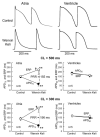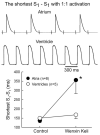Atrial-selective inhibition of sodium-channel current by Wenxin Keli is effective in suppressing atrial fibrillation
- PMID: 21884675
- PMCID: PMC3236802
- DOI: 10.1016/j.hrthm.2011.08.027
Atrial-selective inhibition of sodium-channel current by Wenxin Keli is effective in suppressing atrial fibrillation
Abstract
Background: Wenxin Keli is a Chinese herb extract reported to be of benefit in the treatment of cardiac arrhythmias, cardiac inflammation, and heart failure.
Methods and results: We evaluated the electrophysiologic effects of Wenxin Keli in isolated canine arterially perfused right atrial preparations with a rim of right ventricular tissue (n = 11). Transmembrane action potentials and a pseudoelectrocardiogram were simultaneously recorded. Acetylcholine (1 μM) was used to induce atrial fibrillation (AF) and to test the anti-AF potential of Wenxin Keli (5 g/L). Wenxin Keli produced preferential abbreviation of action potential duration measured at 90% repolarization (APD(90)) in atria, but caused atrial-selective prolongation of the effective refractory period, due to the development of postrepolarization refractoriness. The maximum rate of rise of the action potential upstroke was preferentially reduced in atria. The diastolic threshold of excitation increased in both atria and ventricles, but much more in atria. The duration of the "P wave" (index of atrial conduction time) was prolonged to a much greater extent than the duration of the "QRS complex" (index of ventricular conduction time). Wenxin Keli significantly reduced I(Na) and shifted steady-state inactivation to more negative potentials in HEK293 cells stably expressing SCN5A. Wenxin Keli prevented the induction of persistent AF in 100% atria (6/6) and, in another experimental series, was found to terminate persistent acetylcholine-mediated AF in 100% of atria (3/3).
Conclusion: Wenxin Keli produces atrial-selective depression of I(Na)-dependent parameters in canine isolated coronary-perfused preparations via a unique mechanism and is effective in suppressing AF and preventing its induction, with minimal effects on the ventricular electrophysiology.
Copyright © 2012 Heart Rhythm Society. Published by Elsevier Inc. All rights reserved.
Figures








Comment in
-
The Chinese herb extract Wenxin Keli: atrial selectivity from the Far East.Heart Rhythm. 2012 Jan;9(1):132-3. doi: 10.1016/j.hrthm.2011.11.030. Epub 2011 Nov 22. Heart Rhythm. 2012. PMID: 22116050 No abstract available.
References
-
- Fuster V, Ryden LE, Cannom DS, et al. 2011 ACCF/AHA/HRS Focused Updates Incorporated Into the ACC/AHA/ESC 2006 Guidelines for the Management of Patients With Atrial Fibrillation A Report of the American College of Cardiology Foundation/American Heart Association Task Force on Practice Guidelines Developed in partnership with the European Society of Cardiology and in collaboration with the European Heart Rhythm Association and the Heart Rhythm Society. J Am Coll Cardiol. 2011;57:e101–e198. - PubMed
-
- Nattel S, Carlsson L. Innovative approaches to anti-arrhythmic drug therapy. Nat Rev Drug Discov. 2006;5:1034–49. - PubMed
-
- Burashnikov A, Di Diego JM, Zygmunt AC, Belardinelli L, Antzelevitch C. Atrium-selective sodium channel block as a strategy for suppression of atrial fibrillation: differences in sodium channel inactivation between atria and ventricles and the role of ranolazine. Circulation. 2007;116:1449–57. - PMC - PubMed
Publication types
MeSH terms
Substances
Grants and funding
LinkOut - more resources
Full Text Sources
Other Literature Sources
Medical
Miscellaneous

